Keywords
|
| configurator, abstract information model of object, imitation modeling, compiler, virtual machine, visual integrated development environment |
INTRODUCTION
|
| Concept «configuration» in information technologies, which generally means the state of structure for any system, used, as a rule, during establishment of structure of the information system on the basis of its constituents from one or another point of view. Configuration of program complexes, which are intended for the use in the real terms of changes of situational requirements to their functionality on the basis of integration of existent software packages and those, that are developed for implementation of new functions (basic, additional, providing) and for providing of compatibility, is the most substantial and difficult in creation of modern IT. |
| Interdependence of configuration problems of the program complexes for the decision of functional tasks of preparation of building and objects and processes information modeling on the different phases of buildings life cycle requires the search of new ways of creation of more effective system integration and flexible structuring methods, models and facilities and increase of intellectuality of information technologies in building due to development of conception of configuring of program complexes. Consequently multifunction configured information systems research is actual, taking into account specific tasks of preparation of building. |
RELATED WORK
|
| A configurator [1-5] is a complex of the programs, which allows complex IT structuring and organizing for engineer, communication, economic, organizational subject domains with realization of certain functional tasks with the set ultimate goal and adaptation to the concrete typical situations. |
| Being based on the standard of SWEBOK (Software Engineering Body of Knowledge) the author offered conceptual principle scheme of configurator which consists of three parts: system which is under configuring (configured system); system which determines configuration (analytical system of model configuration); and system which executes configuration (configuring system) [6]. Selected components of configurator are connected with dependences as shown in Fig. 1. |
| In complicated configurators, configuring real IT system, all three constituents (configured system, analytical system of model configuration and configuring system) are valuable and obviously expressed. To them, for example, belong: configurators of Web – applications, such as Internet – forums configurators, Internet–shops configurators, configurators of any systems with Web-interface (example: bagtracking system JIRA); configurators of IT systems on the whole and of up-diffused IT systems: 1C-Bitrix [1]; configurators of special software engineering products: AutoDesk; configurators of the economic organizational systems: SAP R3 [2] and BAAN 4 [3]; configurator of system blocks for simplification of selection process [4], Shoreline Firewall [5]. |
| Configurators which can modify a structure and modules of software are in large multifunction software products, for example, graphic packages (3DMax [7], AutoCAD [8]). |
| Language of building processes modeling AIMO (Abstract information model of object) is created by the author [9]. Conception of information modeling of objects and processes of complete cycle of building includes four intersecting basic hierarchies of investment in the building object information model: volume-planning, structural, technological and organizational. By these hierarchies it is possible to set the object of any complication, using also auxiliary additional systems and hierarchies. Crossings of hierarchies allow providing of properties of building object information model, which were not mentioned in such a way before. Hierarchical information models are taken into account taxonomical copulas between the levels of different hierarchies and relations of mereology. |
PROPOSED ALGORITHM
|
| Basis of architecture of the created information technology for preparation of building and management of building operations on the basis of conception of configurators is BIM — Building Information Model. |
| Conception of AIMO language (Abstract information model of object) is developed. Principles of AIMO construction: hierarchical structure of build processes modeling; conducting and development estimate-production normative base of build processes; forming of technological and organizational models of building objects; a resource analysis of build processes norms and AIMO models; estimation and comparison of AIMO models; forming, analysis, evaluation of calendar plans; monitoring of the planned objects building tasks. The AIMO language consists of compiler, virtual machine, as a design mean, and visual integrated development environment (IDE) of language. |
| The AIMO language unites possibilities of imitation modeling languages of difficult processes and universal programming languages, is based on the flexible going near subject domain description on the base of taxonomical and mereological hierarchies, and allows to describe: static models – description of constructions (buildings, fragments), description of resources and dynamic models - description of technology of constructions building. Information and knowledge constituents can be divided into compiled and modeled part. |
| AIMO compiler basic task is to convert the source code of structural and technological models, and also resources in the hierarchical structures of data. |
| Principle of the object-oriented programming is used to form hierarchical structure. The base element of hierarchical structure is a knot - Node. Algorithm of initializing of the modeling part of AIMO language is proposed, which means creation of all necessary objects, taking part in an imitation modeling - mereological hierarchy, coming from information, set in compiled part [10]. |
| Every knot is characterized by the sets of connections, fields and code logic. Set of connections (relations): Rel = (Relh ,Relc) , where Relh - is a relation in hierarchy which allows to set a taxonomical hierarchy, Relc - is a relation of containing, which allows to set a mereological hierarchy. Relations in hierarchies and relations of containing are characterized by axioms: relations in a hierarchy are forming by the inheritance mechanism of classes, relations of containing are realizing due to description of class or names space. |
| AIMO supports different subtypes of knots; basic knots are structural, technological and resource ones. Each of knots subtypes has additional elements in the fields, logic of code sets, and connections sets, which are predefined by the specific of knot subtype. |
| It is possible to set the arbitrary amount of attributes in structural knots. Knots have the area and volume fields by default. Resource knots have the preliminary set field of resource unit cost, and every organizational and technological knot is characterized by connection with a structural knot, which organization and creation technology it describes. |
| Instantiation process. Instantiation is a transitional link between compiling and imitation modeling and is intended for development of relation in hierarchy Relh and r relations of containing Relc in the complete system. |
| In the terms of the object-oriented programming the process of instantiation looks like the process of creation of class instantiations, thus class data will be initialized for a current class and chain of paternal classes: Inst = Instantiate(N) , where Instantiate - is a main instantiation function (there is development of relations: creation of class instantiation on the template), N - is set of knots ( Node ) and knots subtypes, |
 |
| Imitation modeling of the AIMO virtual machine will realize the process of estimation and choice of quasioptimal strategy of going near the object building and detailed plan of building or its separate constituents with the estimations of terms, resources volumes, budget, risks etc. |
For imitation modeling formalization of life cycle of creation of building object or its constituents lets enter such denotations:  F - is main function of optimizations (combined criterion), Foi - are functions-criteria of optimization, F - is main function of optimizations (combined criterion), Foi - are functions-criteria of optimization,  where ki - is weight of every criterion. where ki - is weight of every criterion. |
| The examples of optimization criteria of complete cycle of building are minimization of requirement in financial streams, labour resources, time of implementation of works. The system also allows to set the criteria of user, which arise up at implementation of works, for example, priority of the use of certain resources. |
| The structural and organizational and technological hierarchical models of building project are provided by such information: |
1. IRWij - integral requirement of i -th work in a j -th resource (in units-days),  ( NW - is general amount of works), ( NW - is general amount of works),  (NR - is general amount of resources). The general amount of works can considerably exceed the amount of works, described in AIMO language, because AIMO allows multiple use of fragments and templates of structural and organizational and technological hierarchies, which on this stage are opened out in the flat (not hierarchical) set of atomic works. (NR - is general amount of resources). The general amount of works can considerably exceed the amount of works, described in AIMO language, because AIMO allows multiple use of fragments and templates of structural and organizational and technological hierarchies, which on this stage are opened out in the flat (not hierarchical) set of atomic works. |
2. LWi - set of limitations of i -th work  , where LWiTimeMin - is limitation for i -th work, namely, it’s minimum duration, LWiTimeMax - limitation for i -th work, namely, it’s maximal duration, LWiTimeStart - is directive limitation for time of beginning i -th work. , where LWiTimeMin - is limitation for i -th work, namely, it’s minimum duration, LWiTimeMax - limitation for i -th work, namely, it’s maximal duration, LWiTimeStart - is directive limitation for time of beginning i -th work. |
3. LWij - set of limitations of pair i -th work, j -th work (limitation can include the arbitrary amount of works – not only pair)  LWijOrder - is limitation of works order i and j (beginning of one work required completion of the other, simultaneity of works etc.), LWij Alter - is possibility of alternativeness of works i and j . ???? allows to set alternative works with the flexible system of priorities. LWijOrder - is limitation of works order i and j (beginning of one work required completion of the other, simultaneity of works etc.), LWij Alter - is possibility of alternativeness of works i and j . ???? allows to set alternative works with the flexible system of priorities. |
Basic function of imitation modeling:  where LSRi - is set of stream limitations of i -th resource (1 ≤ i ≤ NR) LSC - is set of financing stream limitations where LSRi - is set of stream limitations of i -th resource (1 ≤ i ≤ NR) LSC - is set of financing stream limitations  RWij t - is intensity of consumption of j -th resource (in units) in the moment of time t within the framework of i -th work, TSi - is the estimated time of beginning of i -th work, TFi - is the estimated time of completion of i -th work. Intensity of consumption of j -th resource (in units) in the moment of time t within the framework i -th work RWij (t) - is one of basic component of input data of imitation modeling function, which provides complete general information on the use of resources of every work within the framework of the designed structure life cycle of building or its constituents. As an input data the imitation modeling function gives out the specified model of implementation of works with the defined values of times of beginning and completion of every work and other information. Output data can be in future presented in a table, graphic, hierarchical form. A reflection in a hierarchical form is provided due to ability of AIMO to connect the result modeling data with input data. RWij t - is intensity of consumption of j -th resource (in units) in the moment of time t within the framework of i -th work, TSi - is the estimated time of beginning of i -th work, TFi - is the estimated time of completion of i -th work. Intensity of consumption of j -th resource (in units) in the moment of time t within the framework i -th work RWij (t) - is one of basic component of input data of imitation modeling function, which provides complete general information on the use of resources of every work within the framework of the designed structure life cycle of building or its constituents. As an input data the imitation modeling function gives out the specified model of implementation of works with the defined values of times of beginning and completion of every work and other information. Output data can be in future presented in a table, graphic, hierarchical form. A reflection in a hierarchical form is provided due to ability of AIMO to connect the result modeling data with input data. |
Limitation of stream of resources:  NO - is an amount of limitations, NO - is an amount of limitations,  ts - is time of beginning of limitation, tF - is time of end of limitation, SMax - is a limit of limitation (integral, for period). ts - is time of beginning of limitation, tF - is time of end of limitation, SMax - is a limit of limitation (integral, for period). |
Verification of criterion (for limitation of present volume of j -th resource):  , the integral chart of supplying with financial resources is set, in presentation of user it is possible to set the constituent of tailings of resources on beginning of period, , the integral chart of supplying with financial resources is set, in presentation of user it is possible to set the constituent of tailings of resources on beginning of period,  |
Limitation of stream of financing: Pi(t) - is a cost of unit of i -th resource in the moment of time t ,  , or units-days, if it is a human or machine resource. , or units-days, if it is a human or machine resource. |
Criterion:  , where LSCk(t) - is a function of limitation of financing stream for time t, Nsc - is an amount of limitations of financing stream. , where LSCk(t) - is a function of limitation of financing stream for time t, Nsc - is an amount of limitations of financing stream. |
| The system expects intensity of financing as sum of intensities of all works, which are executed in this moment of time. Intensities of works are calculated as a product of intensity of consumption of j -th resource (in units) in the moment of time t within the framework of i -th work RWij(t) and the cost of unit of resource Pi(t) in the moment of time t . AIMO allows to set the arbitrary rule of forming of resources cost depending on time. |
| Criteria of optimization. AIMO supports the wide spectrum of optimization criteria, which can be formed on the basis of any information, accessible within the framework of imitation modeling. Basic criteria are: |
Streams of resources. Minimization of spade value:  for j -th resource, Maxt - is complete time of modeling, for j -th resource, Maxt - is complete time of modeling,  . This criterion can be widely used in the cases of user limitations of suppliers, compositions, logistic, limitations in providing of works resources. . This criterion can be widely used in the cases of user limitations of suppliers, compositions, logistic, limitations in providing of works resources. |
Stability of stream:  . This criterion can profit for providing of evenness of consumption of resources which is useful forlogistic. . This criterion can profit for providing of evenness of consumption of resources which is useful forlogistic. |
| Optimization on time. Basic optimization on time is optimization of general time of implementation of complex of works (building of object, of separate parts etc.): Maxt → min , Maxt - is complete time of modeling. |
Minimization of duration for certain work:  - is time of beginning of i -th work, TFi - is time of completion of i -th work. This criterion is the flexible mechanism of forming of the special limitations of user, which are determined by the internal or external factors of enterprise. - is time of beginning of i -th work, TFi - is time of completion of i -th work. This criterion is the flexible mechanism of forming of the special limitations of user, which are determined by the internal or external factors of enterprise. |
Optimization on the integral amount of resources:  for j -th resource 1≤ j ≤ NR ts- is time of beginning and completion of optimization period. for j -th resource 1≤ j ≤ NR ts- is time of beginning and completion of optimization period. |
Optimization for to the integral financial expenses for certain period:  Pjt - is a cost of unit of j -th resource in the moment of time t , Pjt - is a cost of unit of j -th resource in the moment of time t ,  - is time of beginning and completion of optimization period. - is time of beginning and completion of optimization period. |
| Optimization on the integral amount of resources and optimization on the integral financial expenses for certain period are the alternatives of optimization on intensities of stream of resources consumption, which allows user to form the special limits on the protracted period of time. For optimization of main function of imitation modeling ofAIMO virtual machine the dynamic programming is used. |
| At implementation of imitation modeling structural and technological models, written in AIMO language, the general method of the dynamic programming is used next to the method of forks and limitations, based on principle of avalanche-type fork in obedience to Bellman principle, and also Monte Carlo imitation modeling method. |
| The AIMO language provides the flexible system of account of risks at the organizational and technological decisions of implementation of special purpose complexes of construction works, what allows to form all input data as distributing of probabilities and to get a computer-integrated analysis and final results. Risks can be analyzed separately, on groups or all of them. After a modelling there can be the purchased values of criteria of risk estimation - costs, terms and others. AIMO allows more detailed and flexible description of risks which is impossible in other environments with more fixed rules of description. |
| The AIMO models, on the face of it, look like WBS (Work Breakdown Structure), as in a hierarchical kind describe technologies of object building. However, one of key competitive edges of AIMO there is a presence of «clever» decomposition with the count of chart of works for optimization of planning for the current level of working out in detail of technological tree. High flexibility of AIMO and possibility of going beyond the scopes of «WBS 100% rule» stipulates that it is impossible simply to represent the hierarchy of AIMO in diagrams of works, and with the help of classic methods of the difficult systems modeling, as AIMO model has no fixed structure. A structure mutates depending on a context and measure of decomposition and by classic methods and models the «picture» of the certain state of AIMO structure can be made only. Therefore, for the complete using of possibilities of AIMO for models description it is necessary to use the AIMO language, while for the case of the simplified or limited models it is possible to take advantage of facilitating visual instruments. |
| The AIMO language uses a lot of object-oriented programming principles for providing of description flexibility of logic and dependences between the modules. There is an analogy between the instantiation of class in C++ and modeling of knot in AIMO. It is possible to consider some more slow productivity the certain lack of realization of AIMO as compared to C++. Advantage of language of AIMO is focus on the tasks of building processes, that allows to get the most effective process of programming and modeling, and also that realization in AIMO allows to execute storage and operations with dynamic logic in more safe kind, as an objective model of the modeling knot of AIMO provides an interface and access control. |
EXPERIMENTAL RESULTS
|
| Configurator of IT – the Patterns-maker of Building (C-IT PMB) is developed by author in accordance with the section of Configuration Management of the SWEBOK standard. Primary purposes of C-IT PMB: an increasing of quality level of information technology of configured IT due to the increasing of intellectuality of software products, providing of effective integration of existent software products, for the decision of tasks of a building planning, management, organizational and technological decisions. |
| The generalized scheme of functional structure of C-IT PMB is shown in Fig. 2: base of data and knowledges is a central element; the kernel of configurator is AIMO block which uses created by author AIMO language; configurator blocks are connected with functional and information connections. |
| On the basis of development of conception of configurators and the AIMO language the applied instrumental information technology is created. |
| The scheme of work of AIMO language on the stage of preparation of building is shown in Fig. 3: input data from outsourcings, provided by a visual tool and AIMO engineer, act to AIMO compiler as module descriptions technologies; then data, resources, structural and technological constituents act to AIMO virtual machine. Description of optimization criteria and modeling rules is farther executed, whereupon AIMO virtual machine executes modeling and then requirements in resources and materials, linear and network diagrams are provided as an output. |
| In the PMB (the Patterns-maker of Building) system there are three leading roles which the system can be configured under: author, administrator, and user. PMB in the unfolded variant consists of a few basic parts: PMB - server, PMB - client, additional constituents. Constituents of PMB-server executes key functions: manager of components (base of components), manager of configurations, manager of billing, manager of statistics, manager of control of quality, manager of official and general services. Three basic key elements taking part in a modeling are technologies, construction and resources, each of which has the criteria of optimization. |
| Integrated Development Environment for AIMO (AIMO IDE) (Fig. 4) was developed by author: the environment of AIMO IDE allows in a comfortable format to write the code of description of models in AIMO language, and also to look over the results of compiling and imitation modeling in visual presentation. |
| System of interactive design, the purpose of which is demonstration of possibilities of AIMO language for the tasks of strategic and operative analysis of technologies, support of interactive approach to forming and modification of structural and technological elements next to the maintenance of flexibility of programming language is developed. |
| Sequence of work with the system of interactive modeling includes such elements: development of core logic of structural and technological elements in AIMO language, that is forming of key elements of structure and technology maps of KNAUF; compiling and preparation to the modeling, namely forming by the AIMO compiler structural technological models on the base of text code; interactive design. |
| Visualization of KNAUF C361 partition with fragment of plan of building object is shown in Fig. 5: the special system of visualization allows in the interactive mode to form logic of work of flowsheets, to change dynamically and vary input and output information of elements, look over estimates and diagrams of necessities, executing an interactive modeling. On screen forms framework building of the free planning with columns is shown (Fig. 5). Wall gypsumcardboard partitions are set. The module of construction of calendar plans of works, diagrams of necessity in resources creates concrete plans and diagrams for the managers of works. The system provides docking of the different modules and acceleration of work on the whole. |
CONCLUSION
|
| The multifunctional abstract information model of object (AIMO) is offered by author and AIMO programming and building technologies modeling language is created, which is a basis of configurator of new architecture, offered by author. |
| Experimental software product C-IT PMB has wide possibilities in the decision of preparation of building tasks. |
| |
Figures at a glance
|
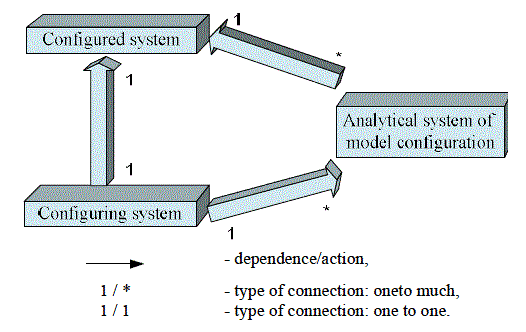 |
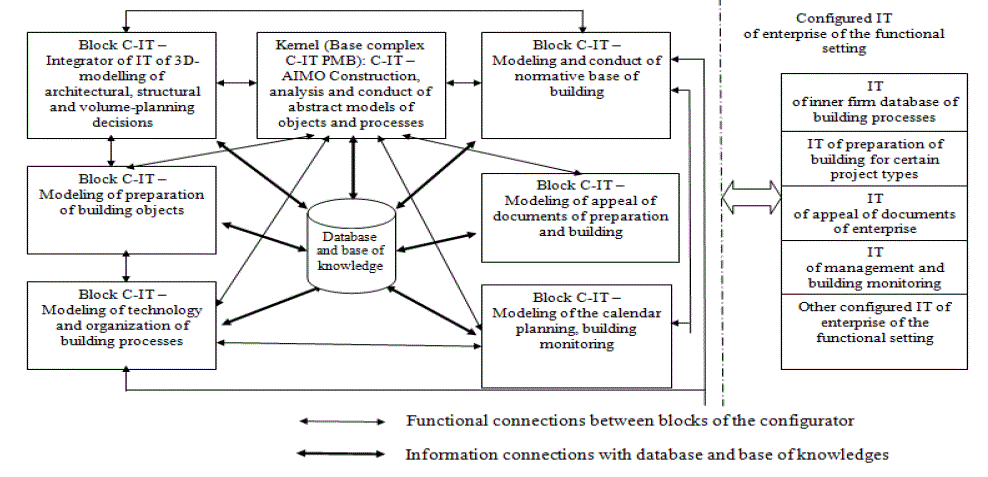 |
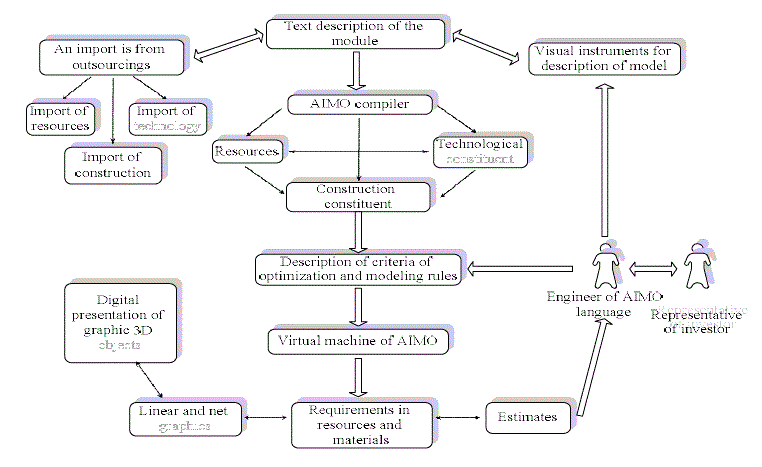 |
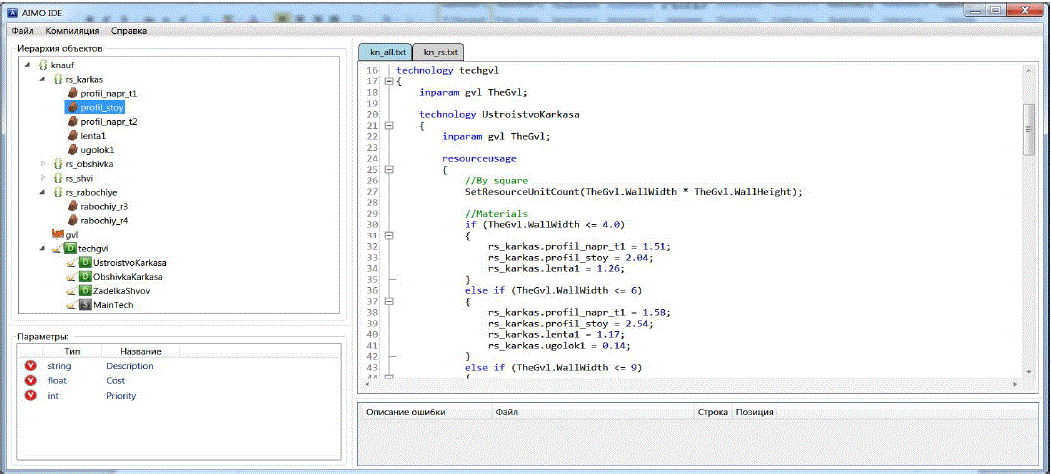 |
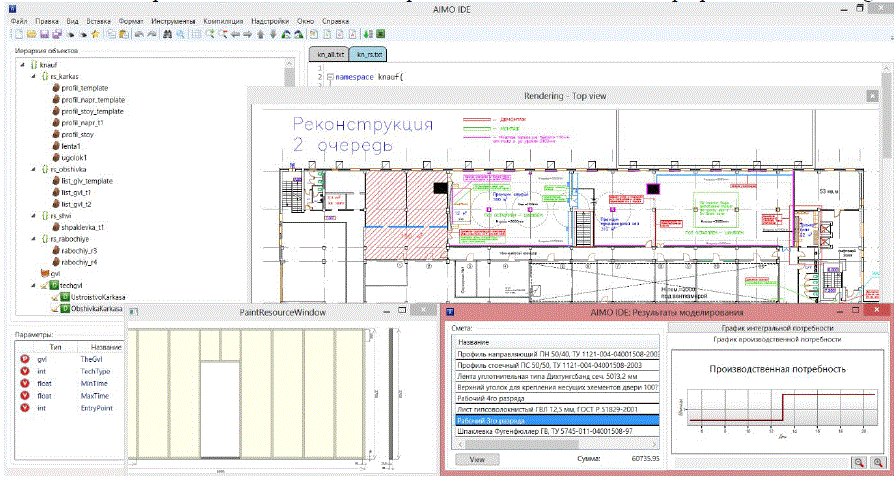 |
| Figure 1 |
Figure 2 |
Figure 3 |
Figure 4 |
Figure 5 |
|
| |
References
|
- 1?-Bitrix. 1c-bitrix.ru. Retrieved from http://1c-bitrix.ru/products/cms/.
- ERP online. SAP R3. Erp-online.ru. Retrieved from http://Erp-online.ru/sap/.
- ERP online. BAAN. Erp-online.ru. Retrieved from http://Erp-online.ru/software/baan/.
- Business Applications Guide. High Performance Systems, Inc., 170 p., 1994.
- Shorewall. IPtables made easy. Important Notices. Shorewall.net. Retrieved from http://Shorewall.net/Notices.html.
- Zadorov, V. B., Vasyliev, O. O. “To development of conception of “configurators” for the construction of information technologies architecture of the organizational anthropogenic systems”, Management of complex systems, Vol.6, pp.107–116, 2011.
- Smith, B. L. “3ds Max 2010 Architectural Visualization”. Support Files for 3DATS.CGschool Books, 2009. Retrieved from http://3dats.com/books.
- Omura, G., Benton, B. C. Mastering AutoCAD 2013 and AutoCAD LT 2013. Retrieved from http://Amazon.com.
- Zadorov, V. B., Vasyliev, O. O., Derevianko, I. V. “AIMO” programming and building technologies modeling language”, Management of complex systems, Vol.13, pp.90–96, 2013.
- Zadorov, V. B., Vasyliev, O. O. “Mathematical models of objects and building processes in the environment of imitation modelling language “??MO”, Management of complex systems, Vol.14, pp.106–115, 2013.
|